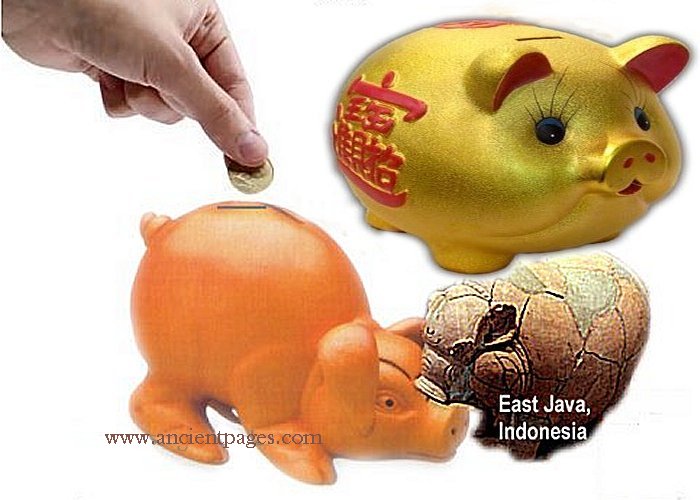Why Is A ‘Piggy Bank’ Shaped Like A Pig?
AncientPages.com - In early European times, most household wares like dishware, jars and barrels were made of dense, orange-colored, economical clay.
People used to put their small savings in kitchen jars made of this clay and called them "piggy jars".
Later, the jars became known as " piggy bank" or " piggy banks" because like all banks, they stored coins inside them.
The etymology of the expression "piggy bank" is rather concealed in obscurity but the most popular story is that during the 1800's, an English jar maker made a mistake.
When some customers ordered " piggy banks", he produced banks but shaped like a pig.
Although the customers did not get what they expected, they liked the final product very much. Funny pigs delighted children and the customers were really fond of them!
Soon, all potters and jar makers were overwhelmed by new orders to produce toy-like figurines representing a pig, which had no hole in the bottom, so the pig had to be broken to get the money out.
To this day, in some countries, it is customary to give "piggy banks" as gifts because they are, in fact, great gift ideas for home and office as well.
In these countries, among many deeply held beliefs, there is one saying that pigs bring luck and good fortune.
The "piggy bank" is an ancient phenomenon.
As we know, money, is an important part of human life and apparently to save money is considered to be a deeply rooted custom of humans nature.
A "piggy bank" dated to about 330-280 BC during the excavations on the site of ancient Babylon, not far from Iraq's capital of Baghdad.
Another money box dated back to 2nd century BC, the so-called Priene "piggy bank" of baked clay, was found in ancient ruins of Priene, near Efeso, located south off an ancient Greek seaport of Asia Minor.
See also:
Our Lives Have Always Been Manipulated By Money – Part 1-3
Modern Banking Concept Started In Ancient Babylonian Temples
A great variety of prehistoric money boxes were also excavated in Pompeii and Herculaneum, Italy and a terracotta "piggy bank" shaped like a pig and dated back 1,500 years was unearthed in East Java, Indonesia.
Since ancient times, people have been saving money in pig-shaped containers.
Copyright © AncientPages.com All rights reserved. This material may not be published, broadcast, rewritten or redistributed in whole or part without the express written permission of AncientPages.com
More From Ancient Pages
-
 Magnificent 2,000-Year-Old Treasure Found In Wales Could Point To An Unknown Roman Settlement
Archaeology | May 12, 2023
Magnificent 2,000-Year-Old Treasure Found In Wales Could Point To An Unknown Roman Settlement
Archaeology | May 12, 2023 -
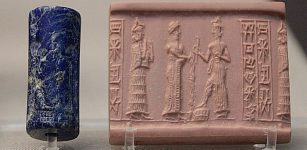 Shamash: Mesopotamian God Of Sun, Truth, Justice And Healing
Featured Stories | Jan 11, 2016
Shamash: Mesopotamian God Of Sun, Truth, Justice And Healing
Featured Stories | Jan 11, 2016 -
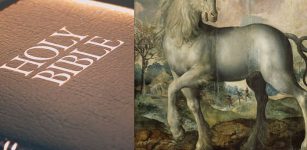 The Unicorn In The Bible Was An Oryx – Ancient Translation Mistake
Ancient History Facts | Apr 24, 2018
The Unicorn In The Bible Was An Oryx – Ancient Translation Mistake
Ancient History Facts | Apr 24, 2018 -
 On This Day In History: Dr Martin Luther King Was Born – On Jan 15, 1929
News | Jan 15, 2017
On This Day In History: Dr Martin Luther King Was Born – On Jan 15, 1929
News | Jan 15, 2017 -
 Paranthropus Robustus Who Lived 2 Million Years Ago Walked Upright Like Modern Humans
Human Beginnings | Mar 7, 2025
Paranthropus Robustus Who Lived 2 Million Years Ago Walked Upright Like Modern Humans
Human Beginnings | Mar 7, 2025 -
 Katana ‘Soul Of The Samurai’ – Most Famous Japanese Sword With Long Tradition
Ancient History Facts | Apr 12, 2018
Katana ‘Soul Of The Samurai’ – Most Famous Japanese Sword With Long Tradition
Ancient History Facts | Apr 12, 2018 -
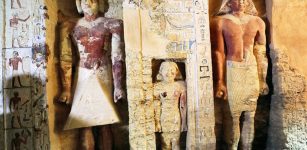 Rare Archaeological Discoveries In The Sacred Animal Necropolis In Saqqara
Archaeology | Apr 26, 2020
Rare Archaeological Discoveries In The Sacred Animal Necropolis In Saqqara
Archaeology | Apr 26, 2020 -
 Owain Glyndwr: Famous Medieval Welsh Warrior Prince And Symbol Of Independence
Featured Stories | Jun 20, 2018
Owain Glyndwr: Famous Medieval Welsh Warrior Prince And Symbol Of Independence
Featured Stories | Jun 20, 2018 -
 Amazing Discovery: Great Pyramid Of Giza And Its Chambers Concentrate Electromagnetic Energy
Archaeology | Jul 31, 2018
Amazing Discovery: Great Pyramid Of Giza And Its Chambers Concentrate Electromagnetic Energy
Archaeology | Jul 31, 2018 -
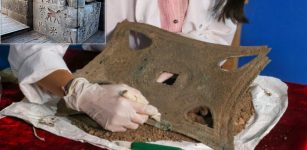 Ornamental Bronze Wall Plate Unearthed In Ayanis Castle Built By Urartian King Rusa II
Archaeology | Sep 13, 2022
Ornamental Bronze Wall Plate Unearthed In Ayanis Castle Built By Urartian King Rusa II
Archaeology | Sep 13, 2022 -
 Sir Francis Walsingham: Spymaster, Politician And Trusted Adviser To Queen Elizabeth I
Featured Stories | Nov 25, 2019
Sir Francis Walsingham: Spymaster, Politician And Trusted Adviser To Queen Elizabeth I
Featured Stories | Nov 25, 2019 -
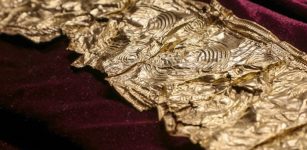 Unique Ornamented Golden Bronze Age Belt Discovered Near Opava, Czech Republic
Artifacts | Oct 28, 2022
Unique Ornamented Golden Bronze Age Belt Discovered Near Opava, Czech Republic
Artifacts | Oct 28, 2022 -
 Rare Ancient Paycheck Of A Roman Legionary Soldier Found At Masada
Archaeology | Feb 16, 2023
Rare Ancient Paycheck Of A Roman Legionary Soldier Found At Masada
Archaeology | Feb 16, 2023 -
 Demise Of Cambodian City Angkor Caused By Decline In Occupation And Not Abrupt Collapse
Archaeology | Apr 18, 2019
Demise Of Cambodian City Angkor Caused By Decline In Occupation And Not Abrupt Collapse
Archaeology | Apr 18, 2019 -
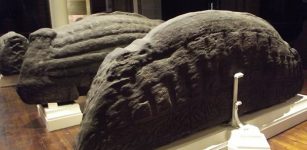 The Govan Stones – Treasures From The Viking Era In Britain
Featured Stories | Dec 27, 2015
The Govan Stones – Treasures From The Viking Era In Britain
Featured Stories | Dec 27, 2015 -
 Magnetic Fields Used To Explore Doggerland And Other Prehistoric Submerged Sites
Archaeology | Mar 10, 2023
Magnetic Fields Used To Explore Doggerland And Other Prehistoric Submerged Sites
Archaeology | Mar 10, 2023 -
 On This Day In History: The Battle of Blore Heath – Sep 23, 1459
News | Sep 23, 2015
On This Day In History: The Battle of Blore Heath – Sep 23, 1459
News | Sep 23, 2015 -
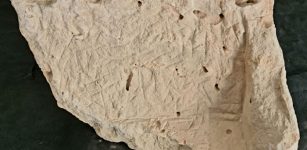 3,500-Year-Old Stone Inscribed With A Curse Against The City’s Governor Discovered In Jerusalem
Archaeology | Jul 13, 2022
3,500-Year-Old Stone Inscribed With A Curse Against The City’s Governor Discovered In Jerusalem
Archaeology | Jul 13, 2022 -
 Evidence Supporting Drumelzier Legend And Merlin’s Death In Scotland Uncovered By Archaeologists
Archaeology | Sep 4, 2024
Evidence Supporting Drumelzier Legend And Merlin’s Death In Scotland Uncovered By Archaeologists
Archaeology | Sep 4, 2024 -
 A 2,500-Year-Old Marble Disc, Designed To Protect Ancient Ships And Ward Off The Evil Eye – Discovered
Archaeology | Aug 4, 2023
A 2,500-Year-Old Marble Disc, Designed To Protect Ancient Ships And Ward Off The Evil Eye – Discovered
Archaeology | Aug 4, 2023

